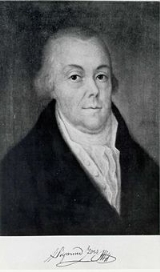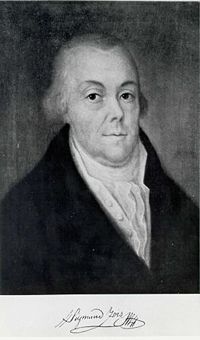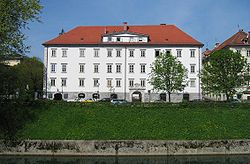
Baron Sigmund Zois von Edelstein
Encyclopedia

Carniola
Carniola was a historical region that comprised parts of what is now Slovenia. As part of Austria-Hungary, the region was a crown land officially known as the Duchy of Carniola until 1918. In 1849, the region was subdivided into Upper Carniola, Lower Carniola, and Inner Carniola...
n nobleman, natural scientist and patron of the arts
Patronage
Patronage is the support, encouragement, privilege, or financial aid that an organization or individual bestows to another. In the history of art, arts patronage refers to the support that kings or popes have provided to musicians, painters, and sculptors...
. He is considered as one of the most influential figures of the Enlightenment Era in the Slovene Lands
Slovene Lands
Slovene Lands or Slovenian Lands is the historical denomination for the whole of the Slovene-inhabited territories in Central Europe. It more or less corresponds to modern Slovenia and the adjacent territories in Italy, Austria and Hungary in which autochthonous Slovene minorities live.-...
of Habsburg
Habsburg
The House of Habsburg , also found as Hapsburg, and also known as House of Austria is one of the most important royal houses of Europe and is best known for being an origin of all of the formally elected Holy Roman Emperors between 1438 and 1740, as well as rulers of the Austrian Empire and...
Austria
Austria
Austria , officially the Republic of Austria , is a landlocked country of roughly 8.4 million people in Central Europe. It is bordered by the Czech Republic and Germany to the north, Slovakia and Hungary to the east, Slovenia and Italy to the south, and Switzerland and Liechtenstein to the...
.
Early life
Sigmund's father Michelangelo Zois (1694–1777) was a LombardianLombardy
Lombardy is one of the 20 regions of Italy. The capital is Milan. One-sixth of Italy's population lives in Lombardy and about one fifth of Italy's GDP is produced in this region, making it the most populous and richest region in the country and one of the richest in the whole of Europe...
merchant who moved to Ljubljana
Ljubljana
Ljubljana is the capital of Slovenia and its largest city. It is the centre of the City Municipality of Ljubljana. It is located in the centre of the country in the Ljubljana Basin, and is a mid-sized city of some 270,000 inhabitants...
where he made a considerable fortune in dealing with iron and holding mines. At his second marriage, he married a Carniola
Carniola
Carniola was a historical region that comprised parts of what is now Slovenia. As part of Austria-Hungary, the region was a crown land officially known as the Duchy of Carniola until 1918. In 1849, the region was subdivided into Upper Carniola, Lower Carniola, and Inner Carniola...
n noblewoman, was nobilitated in 1739 and acquired the right to the title of baron
Baron
Baron is a title of nobility. The word baron comes from Old French baron, itself from Old High German and Latin baro meaning " man, warrior"; it merged with cognate Old English beorn meaning "nobleman"...
in 1760. He owned large estates both in Carniola and on the Kras
Kras
Karst ; also known as the Karst Plateau, is a limestone borderline plateau region extending in southwestern Slovenia and northeastern Italy. It lies between the Vipava Valley, the low hills surrounding the valley, the westernmost part of the Brkini Hills, northern Istria, and the Gulf of Trieste...
, and Sigmund was born in Trieste
Trieste
Trieste is a city and seaport in northeastern Italy. It is situated towards the end of a narrow strip of land lying between the Adriatic Sea and Italy's border with Slovenia, which lies almost immediately south and east of the city...
, in one of his father's palaces.
After attending several private schools, Sigmund Zois moved to Reggio in the duchy of Modena
Modena
Modena is a city and comune on the south side of the Po Valley, in the Province of Modena in the Emilia-Romagna region of Italy....
where he continued his education. He enjoyed traveling and making new acquaintances. However, his way of life was soon truncated by gout
Gout
Gout is a medical condition usually characterized by recurrent attacks of acute inflammatory arthritis—a red, tender, hot, swollen joint. The metatarsal-phalangeal joint at the base of the big toe is the most commonly affected . However, it may also present as tophi, kidney stones, or urate...
, a disease with which he would be stricken the rest of his life. After returning to Ljubljana
Ljubljana
Ljubljana is the capital of Slovenia and its largest city. It is the centre of the City Municipality of Ljubljana. It is located in the centre of the country in the Ljubljana Basin, and is a mid-sized city of some 270,000 inhabitants...
to assist in business, he studied natural sciences with Gabriel Gruber
Gabriel Gruber
Gabriel Gruber was the second Superior General of the Society of Jesus in Russia.-Early years and education:...
and Giuseppe Maffei and inherited his father's wealth in 1777. Leaving the management of his economic entities to his cousin, he developed a strong interest in sciences and started to meet with Baltazar Hacquet
Belsazar Hacquet
Belsazar de la Motte Hacquet, was an Austrian physician and scientist who was born in Le Conquet, France. He studied in Vienna, and was a surgeon during the Seven Years' War. Later he was an instructor of anatomy and natural sciences in Laibach , and in 1788 was a professor at the University of...
, who taught anatomy in Ljubljana from 1773 to 1787, and several Slovene intellectuals of the time.
The Zois circle

Zois Palace
Zois Palace is a mansion in Ljubljana, the capital of Slovenia.The mansion was built between 1765 and 1770, combining older buildings, in the neoclassicist style. It is located on the bank of the Ljubljanica river...
in Ljubljana became a fostering center for liberal
Liberal arts
The term liberal arts refers to those subjects which in classical antiquity were considered essential for a free citizen to study. Grammar, Rhetoric and Logic were the core liberal arts. In medieval times these subjects were extended to include mathematics, geometry, music and astronomy...
intellectuals at the center of the Slovene enlightenment
Age of Enlightenment
The Age of Enlightenment was an elite cultural movement of intellectuals in 18th century Europe that sought to mobilize the power of reason in order to reform society and advance knowledge. It promoted intellectual interchange and opposed intolerance and abuses in church and state...
. Jurij Japelj
Jurij Japelj
Jurij Japelj, also known in German as Georg Japel was a Slovene Jesuit priest, translator and philologist. He was part of the Zois circle, a group of Carniolan scholars and intellectuals that were instrumental in the spread of Enlightenment ideas in the Slovene Lands...
and Blaž Kumerdej (the two published the Bible in Slovene language), Anton Tomaž Linhart
Anton Tomaž Linhart
Anton Tomaž Linhart was a Slovene playwright and historian, best known as the author of the first comedy in Slovene, Županova Micka...
, Valentin Vodnik
Valentin Vodnik
Valentin Vodnik was a Slovene priest, journalist and poet from the late Enlightenment period.-Life and work:He was born in Šiška, now a suburb of Ljubljana, then part of the Habsburg Monarchy...
(from 1793) and Jernej Kopitar
Jernej Kopitar
Jernej Bartol Kopitar was a Slovene linguist and philologist working in Vienna. He also worked as the Imperial censor for Slovene literature in Vienna...
(from 1803) were the most prominent members of what became known as the “Zois circle”. Zois was their patron, mentoring them and granting them necessary financial support for their cultural and scientific efforts, thus becoming the central figure of the Slovenian enlightenment. He was a deist and his views were rational and empirical. Nevertheless, he strongly opposed the French revolution
French Revolution
The French Revolution , sometimes distinguished as the 'Great French Revolution' , was a period of radical social and political upheaval in France and Europe. The absolute monarchy that had ruled France for centuries collapsed in three years...
and supported the moderate enlightened constitutionalism of Leopold II
Leopold II, Holy Roman Emperor
Leopold II , born Peter Leopold Joseph Anton Joachim Pius Gotthard, was Holy Roman Emperor and King of Hungary and Bohemia from 1790 to 1792, Archduke of Austria and Grand Duke of Tuscany from 1765 to 1790. He was a son of Emperor Francis I and his wife, Empress Maria Theresa...
.
In Ljubljana, Zois initiated and sponsored the construction of roads, the foundation of the botanical garden and a (German) theatre (whose main shareholder he became) and the enlargement of the lyceal library. His great commitment in sciences contrasted in neglecting the needs of the farmers on his estates, who waged surrection in 1783 and were oppressed by Zois' managers. Only after the French Revolution he ordered obligation towards his subjects, fearing for his properties.
From 1797 onwards, Sigmund Zois used a wheelchair and didn't leave his mansion in Ljubljana anymore.
The literary opus of Sigmund Zois, of modest quality and little influence, includes many literary forms and genres, ranging from arias for the opera to lyrics for folk music, although probably only a minor part of his work has been preserved. His translation of the poem Lenore
Lenore (ballad)
Lenore, sometimes translated as Leonora, Leonore or Ellenore, is a poem written by German author Gottfried August Bürger in 1773, and published in 1774 in the Göttinger Musenalmanach...
by Gottfried August Burger
Gottfried August Bürger
Gottfried August Bürger was a German poet. His ballads were very popular in Germany. His most noted ballad, Lenore, found an audience beyond readers of the German language in an English adaptation and a French translation.-Biography:He was born in Molmerswende , Principality of Halberstadt, where...
was regarded as a complete failure, and Zois himself later came to the conclusion that the Slovene language was "too mediocre and rough" to allow for such a literary achievement. He would be disproven only some decades later by France Prešeren
France Prešeren
France Prešeren was a Slovene Romantic poet. He is considered the Slovene national poet. Although he was not a particularly prolific author, he inspired virtually all Slovene literature thereafter....
who managed to compose a complex and exceptional translation of the same poem. Zois is also regarded as a father of Slovene literary criticism
Literary criticism
Literary criticism is the study, evaluation, and interpretation of literature. Modern literary criticism is often informed by literary theory, which is the philosophical discussion of its methods and goals...
, and most of his literary reviews can be found in his correspondence with Valentin Vodnik
Valentin Vodnik
Valentin Vodnik was a Slovene priest, journalist and poet from the late Enlightenment period.-Life and work:He was born in Šiška, now a suburb of Ljubljana, then part of the Habsburg Monarchy...
.
Zois, who was considered to have been the wealthiest Carniolan of his time, died in Ljubljana. His funeral was attended by a huge crowd; to these days, it has been considered one of the biggest funeral ceremonies ever held in the city, together with Anton Aškerc
Anton Aškerc
Anton Aškerc was a Slovene poet and Roman Catholic priest, best known for his epic poems.Aškerc was born into a peasant family near the town of Rimske Toplice in the Duchy of Styria, then part of the Austrian Empire . His exact birthplace is unknown because his family was on the move at the time...
's funeral in 1912, and Janez Evangelist Krek
Janez Evangelist Krek
Janez Evangelist Krek was a Slovene Christian Socialist politician, priest, journalist and author.He was born in a peasant family in the village of Sveti Gregor , in what was then the Austrian Empire. His father died when he was a child...
's funeral in 1917.
Other achievements
Much more important are his achievements in mineralogyMineralogy
Mineralogy is the study of chemistry, crystal structure, and physical properties of minerals. Specific studies within mineralogy include the processes of mineral origin and formation, classification of minerals, their geographical distribution, as well as their utilization.-History:Early writing...
, geology
Geology
Geology is the science comprising the study of solid Earth, the rocks of which it is composed, and the processes by which it evolves. Geology gives insight into the history of the Earth, as it provides the primary evidence for plate tectonics, the evolutionary history of life, and past climates...
, botany
Botany
Botany, plant science, or plant biology is a branch of biology that involves the scientific study of plant life. Traditionally, botany also included the study of fungi, algae and viruses...
, and zoology
Zoology
Zoology |zoölogy]]), is the branch of biology that relates to the animal kingdom, including the structure, embryology, evolution, classification, habits, and distribution of all animals, both living and extinct...
. His collection of minerals (around 5,000 items) is kept at the Slovenian National Museum in Ljubljana.
In 1795, he mounted two expeditions to explore the land around the Triglav
Triglav
Triglav is the highest mountain in Slovenia and the highest peak of the Julian Alps. While its name, meaning "three-headed", can describe its shape as seen from the Bohinj area, the mountain was most probably named after the Slavic god Triglav. The mountain is the preeminent symbol of the Slovene...
mountain. In 1805, the mineral zoisite
Zoisite
Zoisite is a calcium aluminium hydroxy sorosilicate belonging to the epidote group of minerals. Its chemical formula is Ca2Al3O...
was named after him, since Zois was the first to correctly assess that the rock found by Simon Prešern in the Carinthian Alps
Alps
The Alps is one of the great mountain range systems of Europe, stretching from Austria and Slovenia in the east through Italy, Switzerland, Liechtenstein and Germany to France in the west....
represented a previously unknown mineral.
Sigmund also supported the work of his brother, the botanist Karl Zois
Karl von Zois
Karl von Zois zu Laibach was an Austrian amateur botanist and plant collector. Von Zois, described as a "country gentleman", lived in the Carniola region of Austria...
who, among other things, discovered the Campanula zoysii
Campanula zoysii
Campanula zoysii is a flower in the genus Campanula .-Range and habitat:...
, a previously unknown Carniola
Carniola
Carniola was a historical region that comprised parts of what is now Slovenia. As part of Austria-Hungary, the region was a crown land officially known as the Duchy of Carniola until 1918. In 1849, the region was subdivided into Upper Carniola, Lower Carniola, and Inner Carniola...
n flower.
The most important scientific award in Slovenia, as well as a state-founded scholarship
Scholarship
A scholarship is an award of financial aid for a student to further education. Scholarships are awarded on various criteria usually reflecting the values and purposes of the donor or founder of the award.-Types:...
for talented students, are named after him.

